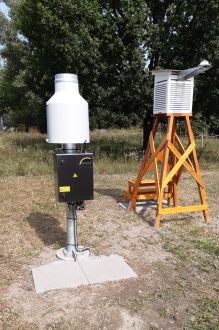Weather stations on the Danube Island
In autumn 2019, five weather stations were installed and put into operation on the Danube Island under the auspices of the EU LIFE DICCA project. The stations are to provide detailed records of weather, atmospheric conditions and microclimatic conditions on the Danube Island throughout the project timeframe.
Locations
The weather stations have been installed in the immediate vicinity of sites earmarked for forthcoming project measures on the Danube Island:
- Inselinfo service centre, near Reichsbrücke bridge
- Festival field, near Floridsdorf Bridge
- Opposite Brigittenauer Bucht
- Tritonwasser
- South of Donaustadtbrücke
The weather stations are situated in fenced enclosures and powered by solar electricity.
What do the weather stations measure?
Four of the weather stations measure air temperature and ground-level humidity. The fifth, on the grassy area at the Inselinfo service centre, measures the above plus precipitation and global solar radiation, which is the sum of the diffuse and direct solar radiation falling onto a horizontal surface on the ground.
The recorded data will be used to measure the impact of the measures implemented under the project. The data will be incorporated into the monitoring report for the LIFE project and serve as the basis for more in-depth analyses and trend calculations.
Surroundings influence the microclimate
The sites for the weather stations were deliberately chosen for their diverse climatic conditions. For example, open grassy areas warm up faster than a site in woodland or in immediate proximity to water. Taking very hot days as an example, we can clearly see the different climatic conditions that prevail in different sites on the Danube Island:
On the hottest day of 2020, 28 July, the weather station at the Inselinfo service centre near the Reichsbrücke bridge recorded a maximum temperature of 35.8°C at 3 pm. On the same day, the weather station at the festival field, which is immediately surrounded by asphalt surfaces, recorded near-ground temperatures of up to 40°C. The station situated in a shady spot at Tritonwasser pond reached a maximum temperature of just over 36°C, while the thermometer at the station south of Donaustadt Bridge, a grassy site with sparse vegetation, climbed to a somewhat higher daily maximum of 37°C.
Improving the microclimate of the Danube Island
Many of the measures planned under the project aim at improving the microclimate of the Danube Island. Bodies of water have a cooling effect on their surroundings. Two new pond habitats are thus being created, and other existing ponds that are in danger of drying out are being revitalised.
The preservation and creation of pond habitats also benefits the animals and plants that live on the Danube Island. Ponds provide a habitat for amphibians, butterflies, dragonflies and an array of other species.
Besides the new pond habitats, new green areas, elements providing shade and newly planted trees will also help to improve the island's microclimate. For instance, new green areas are being laid out in place of asphalt surfaces.
City of Vienna | Water Management
Any questions, requests, or concerns? Please contact the City Service at contact form


